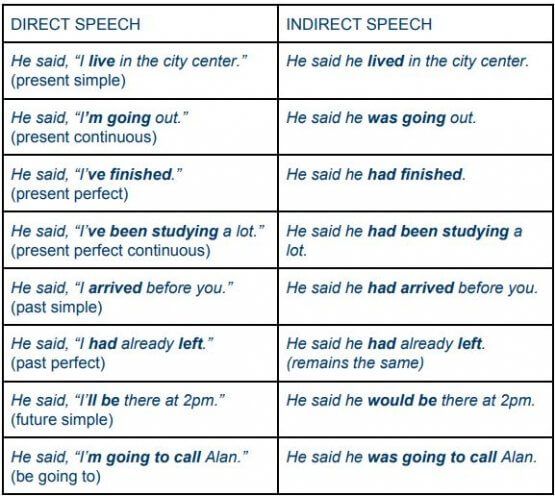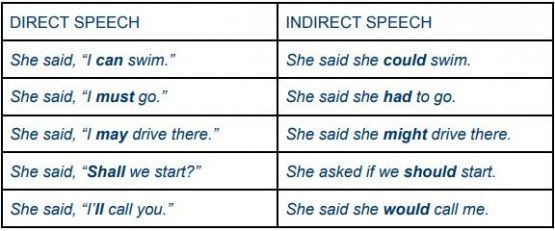直接和間接言語練習
在很多情況下,我們需要描述發生的事件或動作,而這通常包括重複某人說過的話。此類場合包括社交場合以及工作電子郵件或簡報。為了描述人們所說的內容,有兩種不同類型的言語──直接言語和間接言語(或轉述言語)。
閱讀下面的文章以了解有關這些形式的更多資訊並提高您的英語講故事技巧。
直接引語
當我們想要描述某人說的話時,一種選擇是使用直接引語。當我們簡單地重複某人所說的話時,我們會使用直接引語,將短語放在引號之間:
- Paul came in and said, “I’m really hungry.”
在書籍或報紙文章中經常看到直接引語的使用。例如:
- The local MP said, “We plan to make this city a safer place for everyone.”
如您所見,在直接引語中,常常使用動詞「to say」(過去式為‘said’)。但您也可以找到其他動詞用來表示直接引語,例如「ask」、「reply」和「shout」。例如:
- When Mrs Diaz opened the door, I asked, “Have you seen Lee?”
- She replied, “No, I haven’t seen him since lunchtime.”
- The boss was angry and shouted, “Why isn’t he here? He hasn’t finished that report yet!”
間接引語
當我們想要轉述某人所說的話而不用引號,也不必使用完全相同的字詞時,我們可以使用間接引語(也稱為轉述引語)。例如:
- Direct speech: “We’re quite cold in here.”
- Indirect speech: They say (that) they’re cold.
當我們用一般現在式轉述某人所說的話時,就像上面的句子一樣,我們通常不會改變時態,而只是改變主詞。然而,當我們報導過去的事情時,我們通常會透過將時態後退一步來改變時態。例如,在下面的句子中,間接引語中的一般現在式變成了一般過去式:
- Direct speech: “I have a new car.”
- Indirect speech : He said he had a new car.
所有其他時態都遵循間接引語的類似變化。以下是所有主要時態的範例:

將時態後移一步的相同規則也適用於情態動詞。例如:

使用「say」或「tell」
作為使用「say」的替代,我們在間接引語中也可以使用「tell」(過去式為‘told’),但在這種情況下您需要加上受詞代名詞。例如:
- He told me he was going to call Alan.
- They told her they would arrive a little late.
- You told us you’d already finished the order.
改變時間表達方式
有時,當你轉述言語時,有必要改變時間表達方式,特別是當你談論過去並且時間參考不再適用時。例如:
- Direct speech: “I’m seeing my brother tomorrow.”
- Indirect speech: She said she was seeing her brother the following day.
以下是其他一些範例:
- Direct speech: “I had a headache yesterday.”
- Indirect speech: You said you’d had a headache the day before yesterday.
- Direct speech: “It’s been raining since this afternoon.”
- Indirect speech He said it’d been raining since that afternoon.
- Direct speech: “I haven’t seen them since last week.”
- Indirect speech: She said she hadn’t seen them since the previous week.
報告問題
當你轉述一個問題時,你需要將疑問形式改為肯定句,將動詞時態後退一步,就像正常的轉述語氣一樣。
我們可以報告兩種類型的問題——有是/否回答的問題,以及以疑問詞開頭的問題,例如「what」、「where」、「who」等。當我們報告一個是/否問題時,我們使用「if」。例如:
- Direct speech: “Do they live here?”
- Indirect speech: You asked me if they lived here.
如您所見,在該問題的間接引述版本中,「do」被省略,因為它不再是問題,而動詞「live」變成了「lived」。
對於以疑問詞開頭的問題,例如「what」、「where」、「when」、「who」等,我們在報告問題時使用疑問詞,但將疑問形式變為肯定形式。例如:
- Direct speech: “Where do they live?”
- Indirect speech: You asked me where they lived.
- Direct speech: “When are you leaving?”
- Indirect speech: He asked us when we were leaving.
- Direct speech: “How will they get here?”
- Indirect speech: She asked me how they would get here.
當我們報告一個問題時,我們通常使用動詞「ask」。與動詞「to tell」類似,動詞「to ask」通常後面跟隨受詞代名詞,雖然可以省略它。
報告命令和請求
當你向某人下命令時,你使用祈使語氣,這意味著只使用動詞而不使用主詞。例如:
- “Call me back later.”
- “Have a seat.”
- “Don’t do that!”
要報告一個命令,我們使用「tell」和動詞不定式。例如:
- You told me to call you back later.
- He told me to have a seat.
- She told us not to do that.
當您提出請求時,通常使用像「can」、「could」或「will」這樣的詞。例如:
- “Could you call me back later?”
- “Will you have a seat?”
- “Can you not do that please?”
要報告一個請求,我們使用動詞「to ask」和動詞不定式。例如:
- You asked me to call you back later.
- He asked me to have a seat.
- She asked us not to do that.
現在您已經了解了我們如何使用直接和間接語音,請自己練習使用它們。了解它們如何使用的一個極好且簡單的方法是閱讀英文短篇小說或線上新聞文章,因為故事和文章包含許多間接引語的例子。